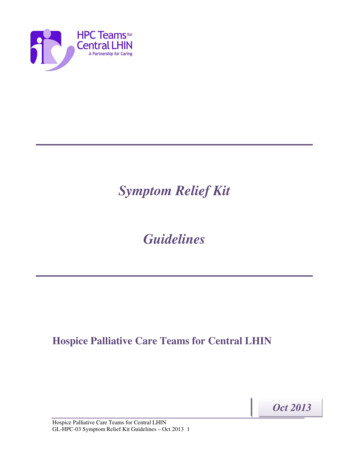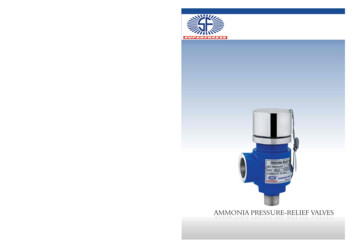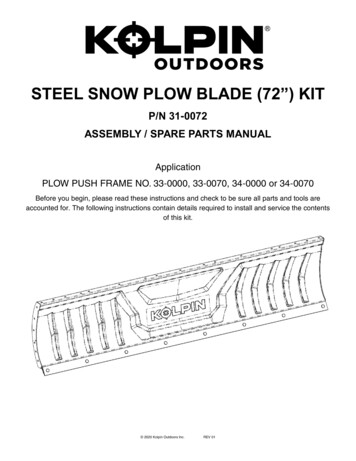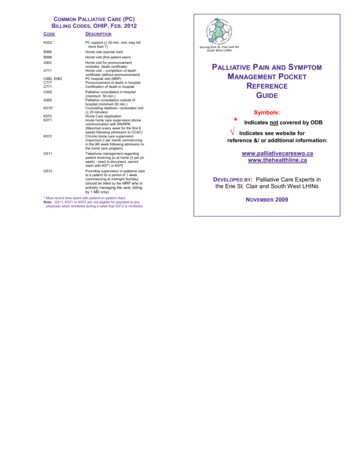
Transcription
Symptom Relief KitGuidelinesHospice Palliative Care Teams for Central LHINOct 2013Hospice Palliative Care Teams for Central LHINGL-HPC-03 Symptom Relief Kit Guidelines – Oct 2013 1
Symptom Relief Kit GuidelinesTable of Contents1.Definition . 32.Why Order a SRK? . 33.When should the SRK be Ordered? . 34.Accessing the SRK . 45.Disposal of the SRK and of Unused Medications . 46.Contraindications to Ordering the SRK. 57.Process for Ordering the SRK . 58.Process for Administration of the SRK . 69.Assessment of Symptoms and Need for Medications in the SRK . 710. Turnaround Time to Delivery or Pick-up . 7Appendix 1 – Palliative Performance Scale. 8Appendix 2 – HPC Teams for Central LHIN Symptom Relief Kit . 9Appendix 3 – Flow Chart on Process for Ordering the Symptom Relief Kit . 11Appendix 3a – Symptom Management Kit Relief Form . 11Appendix 4 – Flow Chart on Process for Administration and Disposition of the SRK . 12Hospice Palliative Care Teams for Central LHINGL-HPC-03 Symptom Relief Kit Guidelines – Oct 20132
Symptom Relief Kit Guidelines1.DefinitionThe Symptom Relief Kit (SRK) is a standardized package of medications andrelated medical supplies provided to a patient who is approaching end-of-life for thepurpose of relieving unanticipated or rapidly escalating symptoms2.Why Order a SRK?While it is predictable that patients facing end-of-life are likely to experienceincreasing symptoms, sometimes the timing of these symptoms is not predictable.Having a SRK on hand ensures that the community nurse has a well thought outtool kit and instructions to make it possible for the nurse to respond quickly andappropriately to ease the patient’s unanticipated or rapidly escalating symptoms. Atthis time the SRK is the only available option for emergency symptom managementfor in-home patients when the patient’s physician is not immediately available.The SRK is not intended to replace the need for proper clinical assessment leadingto well defined care plans that properly identify potential issues3.When should the SRK be Ordered?The decision regarding when the SRK goes into the home should be a part of thedevelopment of the patient’s overall plan of care. The development of the planshould involve the patient, the patient’s family, the attending physician, theCommunity Nurse, CCAC Care Coordinator, HPC Teams Clinical NurseConsultant and any other members of the patient’s care ice Palliative Care Teams for Central LHINGL-HPC-03 Symptom Relief Kit Guidelines – Oct 20133
Symptom Relief Kit GuidelinesThe timing and placement of the SRK requires careful consideration. Placing theSRK in the home prematurely may result in the expiry of the medication. Placingthe SRK in the home too late in the patient’s disease process could cause delay inthe management of his/her symptoms and may result in an Emergency Room orhospital admission.Patients who are approaching the end of life phase of their illness with a PalliativePerformance Scale (PPS)* of 40% or less or are deteriorating rapidly should have akit in place. (* see Appendix 1).4.Accessing the SRKIt is appropriate to use the SRK in emergency situations when: 5.The patient has sudden symptoms that cannot be managed at home by themedication already available to the patient; orIt is not possible to access the patient’s physician and /or pharmacy quicklyenough to relieve the patient’s symptoms through additional prescriptions; orThe symptoms are of such intensity that, without the SRK, a visit to theemergency room would be required.Disposal of the SRK and of Unused MedicationsThe SRK is for the use of the designated patient only. Both the Pharmacy Act andthe Standards of Practice for Pharmacists require that any medications and/orsupplies remaining in the kit that have been ordered for the patient as a part of a kit,must be disposed of and destroyed after the designated patient has died. TheCommunity Nurse must ensure the family are aware that any unused medicationsmust be disposed of by placing them in the bio-hazard waste container. TheCommunity Nurse must contact the CCAC Care Coordinator to request ‘pickup’ ofthe waste container. The pharmacy will destroy the unused contents of the SRK inaccordance with the Standards of Practice.The reason that the remaining medications and supplies cannot be used by anotherpatient is to protect the safety of the consumer and for infection control reasons.The SRK is not under the pharmacy control once it is in the home. It is possible, forexample, that the kit was stored at an incorrect temperature or in an unsterileenvironment. Ensuring patient safety outweighs the relatively small financial lossincurred by discarding unused medications.Hospice Palliative Care Teams for Central LHINGL-HPC-03 Symptom Relief Kit Guidelines – Oct 20134
Symptom Relief Kit Guidelines6.Contraindications to Ordering the SRKA SRK is contraindicated for patients in the home when: 7.The patient’s death is imminent, and specific medications should be orderedfor end-of-life care;The patient is a child whose weight is such that medications and /or dosagesrequire special consideration;The patient is incapable and there is no caregiver in the home who can beresponsible for the SRK;There is evidence of substance use disorder by the patient and/or family and noeffective plan can be implemented to prevent medication misuse;There is evidence that the medication in the SRK could be used in ways otherthan the intended purpose; and /orThe security of the SRK in the home cannot be guaranteed.Process for Ordering the SRK The decision to order the SRK is made collaboratively between the CommunityNurse, CCAC Care Coordinator and the Physician, based on the PPS 40%,and other signs and symptoms indicating that the patient is nearing the end-oflife or rapidly deteriorating. The physician completes the Palliative Symptom Relief Kit Prescription,checking the medications of choice and faxing it to the pharmacy and theCCAC. The physician can also order a catheter to be provided with the SRK bychecking this section on the Palliative Symptom Relief Kit Prescription. To comply with the Narcotics Safety & Awareness Act, 2010, the prescriptionmust include the patient identification number and type identification (eg.Health Card, Driver’s License). The prescribing physician must also recordtheir College registration number on the prescription. The CCAC Care Coordinator will fax the Palliative Symptom Relief KitPrescription to any physician who does not have the form, requesting acompleted returned copy. A copy of the Palliative Symptom Relief KitPrescription can be downloaded from the CCAC Extranet or the HPC Teamsfor Central LHIN website. The CCAC Care Coordinator faxes the order to the nursing agency and thepharmacy (Calea or Bayshore), and orders the appropriate medical supplies tosupport the SRK, using the regular CCAC process.Hospice Palliative Care Teams for Central LHINGL-HPC-03 Symptom Relief Kit Guidelines – Oct 20135
Symptom Relief Kit Guidelines8. Supplies need to be ordered if not already in the home including: 1 wastecontainer, 20 alcohol swabs, 2 sc butterfly needles, 10 1cc (TB) syringes with25 gauge needles, 4 (10 x 12) cm Tegaderm, 2 pairs Gloves, 2 PRN adaptors,Transpore Tape. The CCAC pharmacy provider prepares and delivers the SRK and supplies tothe home using the regular CCAC process. The Community Nurse educates the patient & family about the SRK. Thiseducation includes the purpose of the SRK, precautions, safe storage of the kit,and direction for the kit to be used by the primary nurse or physician, unlessotherwise instructed by the nurse. The Community Nurse documents the location of the kit on the progress notesin the chart and puts the SRK order form on top of the more recent medicationorders in the Doctor’s Orders section of the in-home chart. The Nurse alsodocuments the Symptom Relief Kit on the Regular and PRN Medication List inthe In Home Chart and checks the box on the front page of the chart to indicatethe SRK is in place.Process for Administration of the SRK When the patient displays symptoms that require the use of the medications inthe SRK, the Community Nurse contacts the physician to discuss the patient’sstatus and the benefit of medication(s). The Community Nurse administers the medication as ordered by the physicianand documents on the Medication Administration/ Pre-Poured Record. The Community Nurse assesses and plans the ongoing treatment with thephysician. As a guideline, the Symptom Relief Kit provides medications forapproximately 24 hours only. If the nurse is unable to contact the physician when medications in the kitare required, the nurse administers the medication as ordered for the symptomof concern on the Palliative Symptom Relief Kit Prescription and documentsthe administration on the Medication Administration/Pre Poured Record. Thenurse is responsible for informing the physician and CCAC Care Coordinatorimmediately or as soon as possible, within 24 hours, that medication has beenadministered from the SRK. Ongoing treatment plans will be discussed withthe physician.Hospice Palliative Care Teams for Central LHINGL-HPC-03 Symptom Relief Kit Guidelines – Oct 20136
Symptom Relief Kit Guidelines9. Medications utilized from the Symptom Relief Kit are never returned to the kitbecause they have become a part of the treatment plan. Any additionalmedications will require a new physician’s order and prescription. The Community Nurse instructs the family on the appropriate disposal of thekit when it is no longer required. All unused medications are discarded in thebio-hazardous waste container. The CCAC Care Coordinator is contacted toarrange for disposal of the bio-hazard waste container, according to the CCACprocess.Assessment of Symptoms and Need for Medications in the SRKIf a Community Nurse is concerned about his/her ability to assess a symptom and/orto evaluate the need for a specific medication, he/she should consult with thepatient’s physician and contact the clinical resource nurse or supervisor at theiragency for advice. All nurses are accountable for their own decisions and actionsand for maintaining competence in their practice (College of Nurses of Ontario,2006).10. Turnaround Time to Delivery or Pick-upIt is important to anticipate the needs of the patient and to place the SRK in thepatient’s home in a timely manner. All completed paperwork and prescriptionsmust be received before the pharmacy can process the request for a SRK.This document was adapted from the Mississauga Halton Symptom Management KitHospice Palliative Care Teams for Central LHINGL-HPC-03 Symptom Relief Kit Guidelines – Oct 20137
Symptom Relief Kit GuidelinesAppendix 1 – Palliative Performance Scale(Reproduced from Victoria Hospice, 2003)Hospice Palliative Care Teams for Central LHINGL-HPC-03 Symptom Relief Kit Guidelines – Oct 20138
Symptom Relief Kit GuidelinesAppendix 2 – HPC Teams for Central LHIN Symptom Relief KitPALLIATIVE SYMPTOM RELIEF KIT (SRK) PRESCRIPTIONHospice Palliative Care Teams for Central LHINPOLICY1.This is a physician’s order to be implemented by a Registered Nurse when symptoms require urgentintervention to facilitate a comfortable home death.2.The Attending Physician is to be notified as soon as possible regarding change in patient’s condition andneed for ongoing prescription(s).3.EDITH (Expected Death in the Home) protocol should be in place.4.Completed prescription to be FAXED to Pharmacy [Calea / Bayshore ]and CCACDate:Patient Name:Gender:Health Card No:(Last Name, First Name)(or other ID as required under Narcotics Safety Awareness Act )DOB:Address for Delivery:ANXIETY or SEIZURE:Lorazepam tab 1mgDispense: 10 tabsP.O. (not S/L formulation) 1-2 tabs PO/SL q2hr PRN.May crush or dissolve in water to put under tongue.DELIRIUM:Haloperidol Inj 5mg/mlDispense: 3 amps of 5mg2mg SC (0.4ml) q1hr until settled, then 2mg q3-4hr PRNEXCESS PULMONARY SECRETIONS:Atropine 1% Eye DropsDispense: 5ml2 drops SL or buccal q3h PRNNAUSEA:Zyprexa Zydis 5mg Rapid Dissolve Tab (Olanzapine)Dispense: 5 tabsPO once daily, placed on tonguePAIN and/or SHORTNESS OF BREATH:CHOOSE ONLY ONE OPIOIDHydromorphone (Dilaudid) Inj 10mg/mlMorphine Inj 15mg/mlDispense: 4 ampsDispense: 10 ampsOpioid naïve patients with moderate to severe pain ordyspnea usually require 1-2mg sc q1h PRN.Opioid naïve patients with moderate to severe pain usually require 25mg sc q1h PRN.(0.1ml to 0.2ml) use 1cc syringe with needle(2mg 0.13ml; 3mg 0.2ml; 4mg 0.26ml; 5mg 0.33ml) use 1cc syringewith needleIf patient is already on oral hydromorphone / morphine, to convert from patient’s usual dose, take total daily dose and calculate halfto give total parenteral daily dose. Parenteral dose should be divided up over 24 hours.DIRECTIONS (Note – Nurse to use separate butterfly for each medication):ADDITIONAL MEDICATIONS:CCAC TO USE ESTABLISHED PROCESSES TO ORDER THE FOLLOWING SUPPLIES:CATHETER KIT:YesNoSize:SUPPLIES: Alcohol swabs (20), TB syringes (10), Butterfly (2),Tegaderm (4), PRN adaptor (2), Gloves (2 pairs),Transpore tapePhysician SignaturePrint Physician NameCPSO# (required)Physician Contact Numbers:OfficePagerCellFaxPalliative Symptom Relief Kit Prescription – CCAC 159 April 2010Hospice Palliative Care Teams for Central LHINGL-HPC-03 Symptom Relief Kit Guidelines – Oct 20139
Symptom Relief Kit GuidelinesFAX to CALEA: 905-629-0123TEMMY LATNER CENTRE FOR P ALLIATIVE CARESYMPTOM MANAGEMENT KIT PRESCRIPTION FORMDate:Patient Name:Health card#:Tel:Address:SELECTREQ’DITEMS Opioid AnalgesicDIRECTIONS(choose one opioid option only)MITTEAs directed by physicianMorphine 15 mg/ml injectable 1 ml vialHydromorphone 2 mg/ml injectable 1 mlvialAs directed by physicianHydromorphone 10 mg/ml injectable 1ml vialAs directed by physicianMEDICATION333DIRECTIONSHaloperidol 5 mg/ml Injectable 1 ml vialLorazepam 1 mg TabletMITTEFor nausea and vomiting: 0.5 – 1 mg. sc q8h prnFor delirium/agitation: 1 -2 mg. sc q1h prn untilcontrolled then 2 mg. q 6 h sc prnFor sedation: 1 – 2 mg. SL q2h prn (crush tabletand mix with small amount of water)36Midazolam 5mg/ml Injectable 1 ml vialAs directed by physician2Scopolamine 0.4 mg/ml Injectable 1 mlvialFor excess respiratory secretions: 0.4 mg. scq4h prn3Acetaminophen 650 mg Suppository650 mg. pr q4h for temp 38.5o2SUPPLIESCatheter kit (specify size:)Alcohol swabs (20); TB syringes (10); Butterfly (2); Tegadem (4); PRN adaptor (2); Gloves (2 pairs);Transpore tape; Toothette mouth swabs (6)Physician Name (PRINT):Physician Signature:CPSO #:(PCFA)Phone #: 416-586-5133Fax #: 416-586-4804A University of Toronto affiliated patient care, teaching and research centreHospice Palliative Care Teams for Central LHINGL-HPC-03 Symptom Relief Kit Guidelines – Oct 201310
Appendix 3 – Flow Chart on Process for Ordering the Symptom Relief KitHospice Palliative Care Teams for Central LHINGL-HPC-03 Symptom Relief Kit Guidelines – Oct 201311
Symptom Relief Kit GuidelinesAppendix 4 – Flow Chart on Process for Administration and Disposition of the SRKHospice Palliative Care Teams for Central LHINGL-HPC-03 Symptom Relief Kit Guidelines – Oct 201312
The CCAC Care Coordinator faxes the order to the nursing agency and the pharmacy (Calea or Bayshore), and orders the appropriate medical supplies to support the SRK, using the regular CCAC process. Symptom Relief Kit Guidelines Hospice Palliative Care Teams for Central LHIN 6 .










